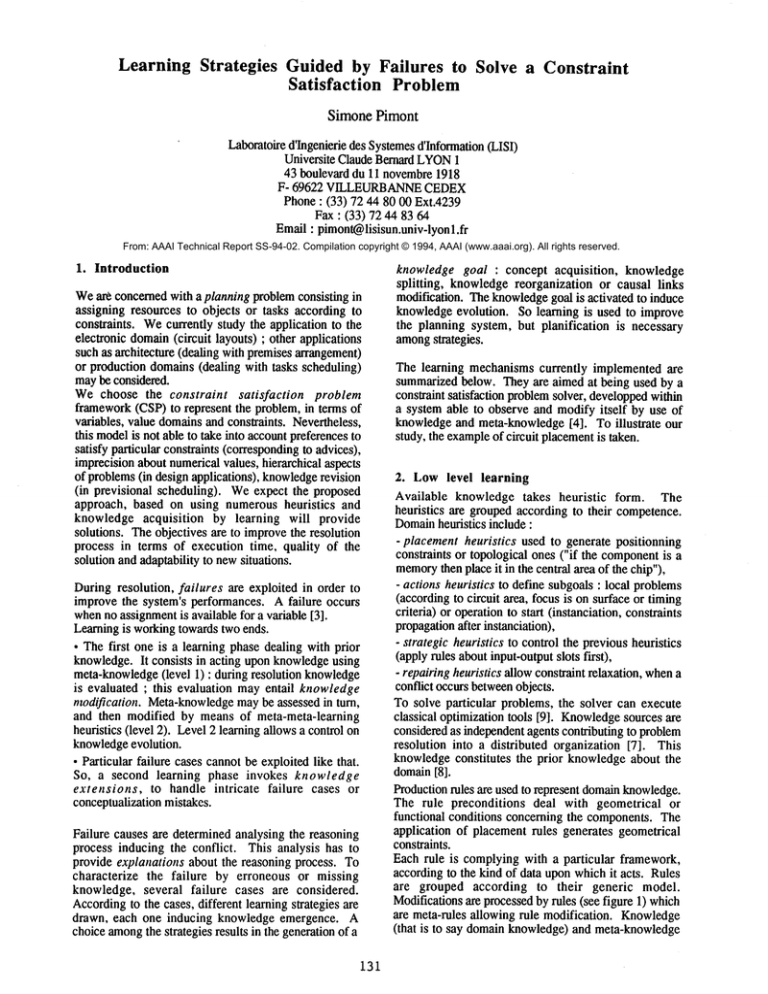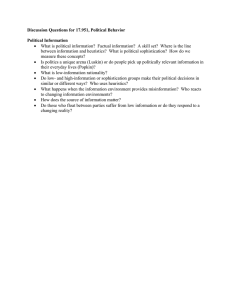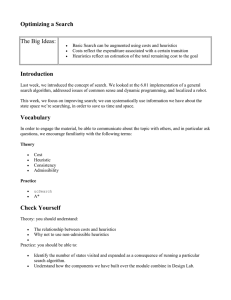
Learning
Strategies
Guided by Failures to Solve a Constraint
Satisfaction
Problem
SimonePimont
Laboratoire d’Ingenierie des Systemesd’Information(LISI)
Universite Claude Bernard LYON
1
43 boulevard du 11 novembre1918
F- 69622 VILLEURBANNE
CEDEX
Phone: (33) 72 44 80 00 Ext.4239
Fax : (33) 72 44 83
Email : pimont@lisisun.univ-lyonl.fr
From: AAAI Technical Report SS-94-02. Compilation copyright © 1994, AAAI (www.aaai.org). All rights reserved.
1. Introduction
Weare concerned with a planning problem consisting in
assigning resources to objects or tasks according to
constraints. Wecurrently study the application to the
electronic domain(circuit layouts) ; other applications
such as architecture (dealing with premises arrangement)
or production domains(dealing with tasks scheduling)
maybe considered.
We choose the constraint
satisfaction
problem
framework(CSP) to represent the problem, in terms
variables, value domainsand constraints. Nevertheless,
this modelis not able to take into account preferences to
satisfy particular constraints (correspondingto advices),
imprecision about numerical values, hierarchical aspects
of problems(in design applications), knowledgerevision
(in previsional scheduling). Weexpect the proposed
approach, based on using numerous heuristics and
knowledge acquisition
by learning will provide
solutions. The objectives are to improvethe resolution
process in terms of execution time, quality of the
solution and adaptability to newsituations.
During resolution, failures are exploited in order to
improve the system’s performances. A failure occurs
whenno assignmentis available for a variable [3].
Learning is workingtowards two ends.
¯ The first one is a learning phase dealing with prior
knowledge. It consists in acting upon knowledgeusing
meta-knowledge(level 1) : during resolution knowledge
is evaluated ; this evaluation may entail knowledge
modification. Meta-knowledgemaybe assessed in turn,
and then modified by means of meta-meta-learning
heuristics (level 2). Level2 learning allows a control
knowledgeevolution.
¯ Particular failure cases cannot be exploited like that.
So, a second learning phase invokes knowledge
extensions, to handle intricate failure cases or
conceptualization mistakes.
Failure causes are determined analysing the reasoning
process inducing the conflict. This analysis has to
provide explanations about the reasoning process. To
characterize the failure by erroneous or missing
knowledge, several failure cases are considered.
Accordingto the cases, different learning strategies are
drawn, each one inducing knowledge emergence. A
choice amongthe strategies results in the generation of a
131
knowledge goal : concept acquisition,
knowledge
splitting, knowledge reorganization or causal links
modification. The knowledgegoal is activated to induce
knowledge evolution. So learning is used to improve
the planning system, but planification is necessary
amongstrategies.
The learning mechanisms currently implemented are
summarizedbelow. They are aimed at being used by a
constraint satisfaction problemsolver, developpedwithin
a system able to observe and modify itself by use of
knowledge and meta-knowledge [4]. To illustrate
our
study, the exampleof circuit placementis taken.
2. Low level learning
Available knowledge takes heuristic
form. The
heuristics are grouped according to their competence.
Domainheuristics include :
-placement heuristics used to generate positionning
constraints or topological ones ("if the componentis
memory
then place it in the central area of the chip"),
- actions heuristics to define subgoals : local problems
(according to circuit area, focus is on surface or timing
criteria) or operation to start (instanciation, constraints
propagationafter instanciation),
- strategic heuristics to control the previous heuristics
(apply rules about input-output slots first),
- repairing heuristics allow constraint relaxation, whena
conflict occurs betweenobjects.
To solve particular problems, the solver can execute
classical optimization tools [9]. Knowledgesources are
considered as independent agents contributing to problem
resolution into a distributed organization [7]. This
knowledge constitutes the prior knowledge about the
domain[8].
Production rules are used to represent domainknowledge.
The rule preconditions deal with geometrical or
functional conditions concerning the components. The
application of placement rules generates geometrical
constraints.
Each rule is complying with a particular framework,
according to the kind of data upon which it acts. Rules
are grouped according to their generic model.
Modifications are processed by rules (see figure 1) which
are meta-rules allowing rule modification. Knowledge
(that is to say domain knowledge) and meta-knowledge
(concerning knowledgeabout the solving process) can
considered in the same way[10].
3.1. Example
Let us consider two placementrules :
- R1 : if block X presents I/O slots over two sides
then place it in a corner-position;
- R2 : if block Y decodes the I/O signals of block X
then place Y on the left side of X ;
andthe strategic rule :
SR1: if rule Ri concerns I/O slots, then give high
priority to Ri .
Supposeblock A presents I/O slots over two sides, and
block B decodesthe I/O signals of block A; then,
I...---
As
I
A"[]
I
Figure 2
-R1 is applied before R2 becauseof SR1
- R1applied to blockAinducesa
positionas in figure2;
- R2applied to B andA leads to a
conflict (becauseB cannotbe placed
onthe left side of A).
In case of this failure, involving R1 R2 and SR1, the
learning process proposedin §2 will lead to :
- modify R1, using PMRj; in the new rule R1’ the
distance between the block X and the circuit side is
increased ; then RI’ allows block B to be placed between
Aand the circuit side ;
- modifySR1, reducing priority in the conclusionpart.
Then, similar pitfalls
will be avoided in future
situations.
However, much more information may be
infered, because of the domain complexity. This
phenomenondoes not occur when the domain is weak.
2.2. Level 2 learning
A frameworkfor modification rules is introduced, similar
to that of domain rules. So, the evaluation of
transformations may entail meta-modifications of the
modificationrules.
An evaluation of parameters is processed, based on
characteristics such as newrule stability, required time
to produce stable rules, their efficiency in terms of
utility for the solving system. Learning is performedby
modifying or removing heuristics acting upon the
learning heuristics of level 1.
Example
Placement rule PRi :
if objl obj2 obj3 are connected and objl is large
comparedwith the others then place obj2 and obj3
on either side of obj I
This rule is of type TPj, whoseform is :
acting on objects list, condition on connections,
condition on size, conclusion on distance
Transformation meta-rules PMRj:
if TPj and often leading to failure then increase
distance by %
This learning is called low level learning because it
allows knowledgemanipulation in terms of structure,
not in terms of semantics [I0].
3. High level learning
The purpose of high level learning is introduced here
through a representative example. It is performed by
wayof system introspection.
132
3.2. Analysis
According to the analysis of the situation, different
explanations may be considered, emphasizing what the
reasonerneedsto learn.
Supposethe concernedsequences are isolated, with their
justifications (here, the three rules R1 R2 and SR1).
Four explanations maybe elaborated, each one leading to
activate a different knowledgeacquisition process.
First view : geometrical space analysis. A geometrical
space analysis leads to consider not only a corner notion
but more precisely four corner positions. So, the
concepts of upper left corner, etc., must be introduced.
Knowledgeis to be revised according to these new
concepts.
Second view : strategy analysis. The order over the
rules is considered. If rule R2 is applied before R1, a
relative placementfor A and B is investigated. First, a
propagation action is activated for the constraint
generated by R2, resulting in a restriction over the
domain values for A. So, SRI is concerned with the
failure : it must be specialized. A knowledgesplitting
is necessary.
Third view : functional analysis. A functional analysis
leads to consider the two blocks A and B as an abstract
functional group. In our example, the nets connecting
A to the I/O pins of the chip need a special treatment,
and B becomes necessary. The group (A,B) was not
present at the beginning of the placement process. It
emerges during the design. The new group will be
introduced into the data structure recording the block
dependencies: the objects hierarchy is to be dynamically
handledduringproblemsolving. Modificationsinto this
hierarchyentail a restructuringof the rules.
Fourthview : conceptualanalysis. Conceptualanalysis
mayinvolve erroneous conceptualization, whenthe
intrinsic properties of the underlying concept are
inconsistent with their usage. The placementof A in
the positionsA’ or A"respects the constraint generated
through the application of R1, and respects the
constraint generated through the application of R2.
However,these positions are erroneous because the
underlyingpurposeof R1 wasto minimizethe length of
nets (makingthe output nets as short as possible). The
relevanceof rules to conceptsmustbe adjusted, and to
do so, rules mustbe reformulated.
This exampleillustrates the necessaryexplanationfor
failures, during repairing, by meansof introspection.
Automaticandsyntactic rule transformationsproposedin
§2 are not sufficient to improveknowledge.Becausethe
statistical parametersabout knowledge
use proposedin
§2 do not fully explain the reasoning process.
Explanationslead to follow multiple learning goals :
concept acquisition, knowledgesplitting, knowledge
organizationor causal links modification.
4. Knowledgegoals and learning strategies
Theaboveexampleis intended to explain the need for
knowledge
extensions,to handleintricate failure cases or
conceptualizationmistakes.
Differentlearningstrategies are applicableaccordingto
"failure cases". Concerningplacementfailure cases,
typical cases havebeenexperimentallystated, through
intensivetests.
Thesuggestedprocessconsists in two steps.
¯ First, the currentconflict is compared
with the failure
patterns.
Prior failure cases are identified. Theidentification of
the failure cases is stated by the lowlevel learning :
failure patterns are inducedthroughinstances of failed
problemexecutions.Sufficient conditionsare associated
for identification: theyconstituteindicatorsfor failure
indexing. Alot of exampleswill be necessaryin order
to drawout significantcases.
When
the analysis involvesa particular failure case, the
case frequencyis modifedto increaseits confidence.So,
manyinstances of a failure maybe requested before
confirming
it as a representativechroniccase.
If, for a particularfailure case, the lowlevel learningcan
modify the concerned rule, producing a new rule
accordingto the pitfall (as RI’ againR1in 3.1), thenthe
newrule is part of the repair processof the failure.
¯ In the event of an unexplainableerror, the metaanalysis about the solvingtrace has to inducea needfor
knowledge.The system currently developpeduses an
actor-oriented language [4] : the solving trace is
organizedas a hierarchical set of exchangedmessages.
Analogiesare drawnin order to produceexplanations[1]
: explanations provide abstract views of execution to
give high level points of view about the execution.
They capture the context : to each explanation are
133
associatedthe analysis context (geometrical,functional,
conceptual),andthe conditionsof its application(block
type, numberof blocks, interaction with nets). It is
used to index the explanations. The self-generated
explanations can convey the beginning of typical
placement
configurations(circular or linear grouping),
typical placementbottlenecks, or functional groupsnot
yet identified.
The explanations provide informations to formulate
learninggoals. All available goals are recordedinto an
agenda.Anappropriatelearning algorithmis selected to
satisfy the chosen knowledge goal, using prior
knowledge.At present, in case of failure to satisfy a
goal, user intervention is needed. Moreresearch is
required to develop a theory able to makeautomatic
informedchoices [11]. In our context, wethink that
failure in satisfying a knowledge
goal maybe considered
in the samewayas failure at the resolutionlevel.
Selected references
1. M.T. CHI, M. BASSOK, M.W. LEWIS, P.
REIMANN
and R. GLASER,
"Self-explanations :
howstudents study and use examplesin learning to
solve problems",Cog. Science, vol.13, 1989, p.145182
2. J. CHOIand S.C. SHAPIRO,"Experience:based
deductive learning", Int. Conf. on Tools for AI,
ICTI’91.
3. R. DECHTER,"Learning while searching in
constraint-satisfaction problems,"AAAI’86.
4. J.M. FOUET,"Building and using technological
memories", in Outils et applications de I’IA en
CFAO,Hermesed., 1990, in french.
5. D.B. LENAT,
"Eurisko : A programthat learns new
heuristics and domain concepts," Artificial
Intelligence, vol.21, 1983,p.61-98.
° S.
MINTON, J.G.
CARBONELL, C.A.
KNOBLOCK,
D.R. KUOKKA,
O. ETZIONI and Y.
GIL, "Explanation-Based Learning : a problem
solving perspective",Artificial Intelligence, vol.40,
1989,p.63-118.
7. S. PIMONT,
"A placement system for constrained
blocks with flexible shapes", Symposiumof
Theoretical Aspects of Computer Science,
STACS’91.
8. S. PIMONT,"Resolution of a combinatorial
constraint satisfaction problem by knowledge
modificationaccordingto learning meta-knowledge",
AAAI’92Workshopon Constraining Learning with
Prior Knowledge,ResearchSummary
p. 107.
S. PIMONT,M. TERRENOIRE,
"Rectangular dual
.
of a graph for circuit placement", Techniqueset
Science Informatique,Vol 12-2/1993,p. 193-216(in
french) ; also at ALCOM"Graph Drawing
Conference".
10. J. PITRAT, "M6taconnaissance : futur de
rlntelligence Artificielle", Hermes,Paris, 1990,in
french.
11. A. RAMand L. HUNTER,
"The use of explicit
goals for knowledge
to guide inferenceandlearning",
Technical Report, GeorgiaInstitute of Technology,
College of Computing,GIT-CC-92/04.




